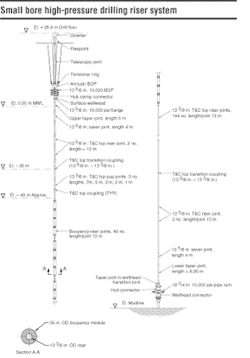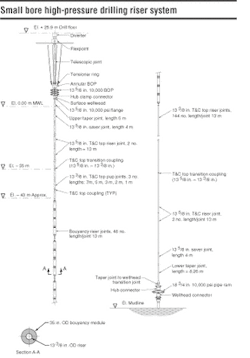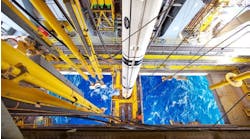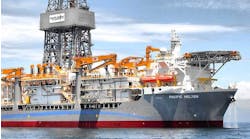Neil Willis
2H Offshore Engineering
Monobore drilling technology continues to gain momentum. The technique involves running a casing string, then forcing through a steel cone to expand it in the hole, in turn allowing identical casing strings to be run through and expanded below. The result is a well hole that progresses as a monobore to the pay zone.
The attraction of moving away from conventional telescoping casing strings is reduced diameter drilling at the top, without a loss in bottom hole flow rates. Drilling becomes faster, and cuttings volume is reduced.
But why not also a slimmer attendant marine drilling riser? This would be lighter and easier to maintain in high tension, less subject to hydrodynamic loading, and would open another advantage normally restricted to calm or shallow-water drilling – the ability to position the BOP on the drilling vessel.
These are some of the issues under review in a new joint industry project (JIP) led by London-based riser consultancy 2H Offshore Engineering. The JIP will cover development, evaluation, and testing of a small-bore, high-pressure drilling riser system using a surface BOP. It will bring together disciplines covering all aspects of drilling, well control, and riser technologies to achieve an optimized solution. Potential benefits identified to date include:
- Lower riser capital equipment cost
- Lower tensions, allowing lower specification vessels and day rates
- Reduced deck space requirements and equipment handling
- Faster installation/retrieval durations
- Faster drilling through reduced cuttings and reduced consumables
- Improved well control and cuttings transport.
Surface BOP
Use of a subsea BOP is standard for mobile offshore drilling operations. This configuration allows the well to be shut-in safely in the event of vessel mooring, dynamic positioning (DP), or riser failures, and also obviates the need for the vessel to support the weight of the BOP stack. Locating the well control functions subsea, however, necessitates use of high-pressure kill and choke lines and a sophisticated control system.
As BOPs have become more complex, this penalty has become more noticeable. Stack heights have risen through the need for additional cavities, and control complexity has increased due to the number of functions and the impact of operating in deeper waters. Further, large-diameter kill and choke lines, booster lines, hydraulic supply lines, and large control umbilicals all increase the riser weight, design complexity, and installation duration.
Riser complexity could be lessened by locating the BOP at the surface, eliminating the need for subsea riser kill and choke lines. The surface BOP would typically include three rams and an annular preventer. On dry tree platforms, great improvements in drilling efficiency have been recorded through use of a surface BOP and high-pressure riser.
However, the requirement for riser disconnect due to possible DP or mooring failures will mean that some well isolation would be required at the riser base. This could be in the form of a single lightweight BOP ram and disconnect package at the seabed to close in and isolate the well.
Riser configuration
If the riser could be reduced from the conventional 21-in. outside diameter (OD) to 13 3/8-in., the steel weight of this system drops from 210 lb/ft to 107 lb/ft, a 50% saving. In a water depth of 7,500 ft, a top tension of only 1,000 kips would be needed, assuming 250 kips of buoyancy. With such an arrangement, all deepwater rigs could be upgraded to operate in 10,000 ft of water, and many existing shallow water rigs would be operable in depths to 7,500 ft.
This degree of shift in drilling riser configuration might prove as unpopular with drilling contractors as top-drives were in the early 1990s. But the attractions to the operators should be clear – lighter, more controllable equipment allowing a much wider choice of drilling vessel specification, reducing rates and drilling timescales.
The HP Drilling Riser JIP will be conducted in three phases. Phase I will consist of engineering studies to define and develop the new riser systems, interfaces, and drilling programs, and will allow the sponsor group to convene and steer the future work scope. Phase II will comprise testing and qualification activities for the critical components, and Phase III will progress to full-scale field trials.
The technical and economic advantages of this technology should overcome resistance within the industry to new approaches and new equipment. The technology has implications for cheaper exploration and production wells in deepwater and could open the door for development of the many deepwater marginal fields that lay untapped worldwide.




